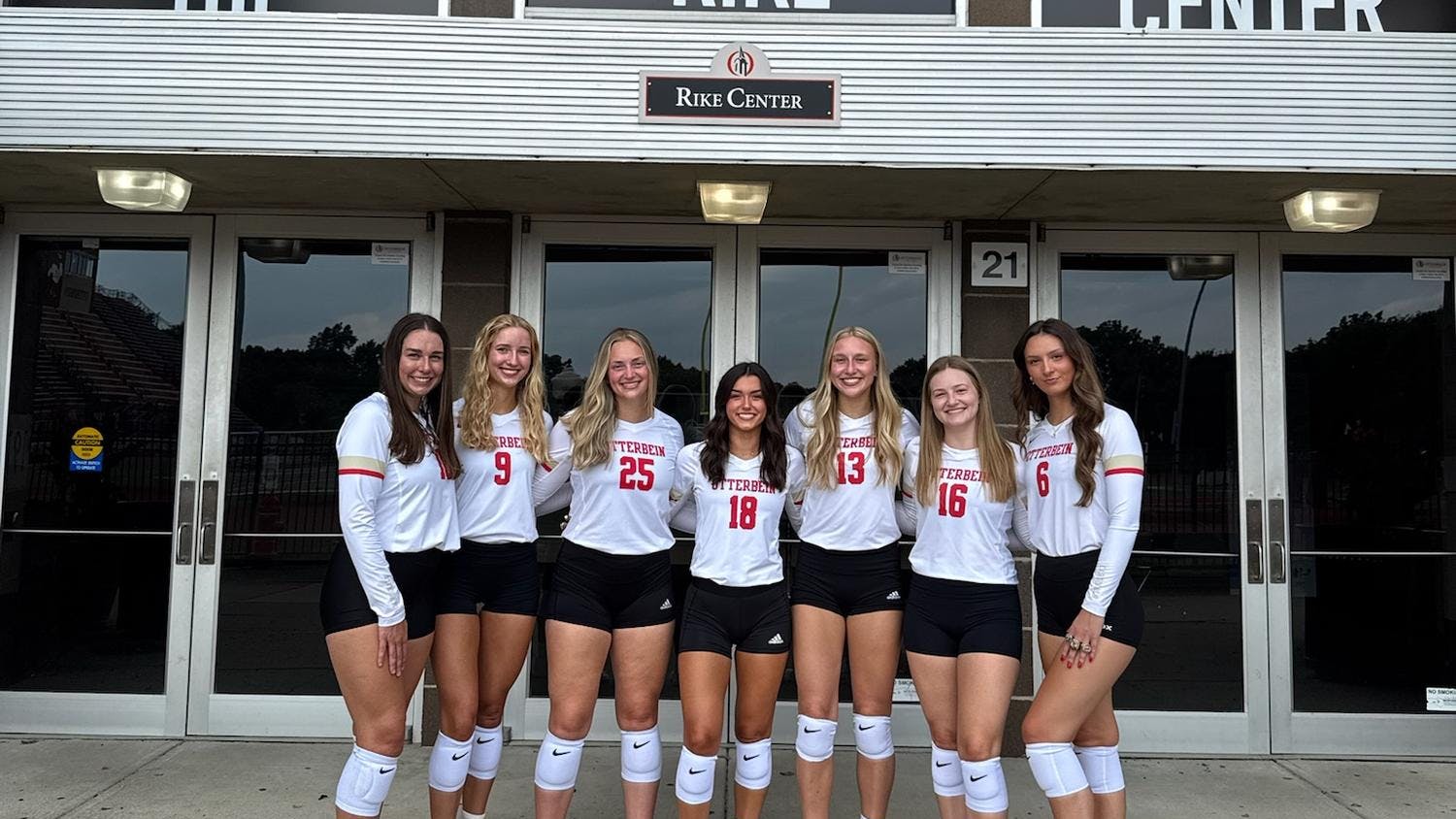Over the past several decades, our country has seen a dramatic shift in college athletics becoming more powerful and having more of a say in what drives each university as a whole.
Many universities across the country would not be where they are without athletics, nor would their athletics be where they are without academics.
Victoria McGillin, Otterbein’s provost and vice president of Academic Affairs, supports this cohesion of value between athletics and academics.
“If we’re not granting credits and degrees, then there are no teams to be had,” McGillin said. “But, due recognition to scholar-athletes who have the opportunity to participate in activities outside of class.”
The relationship between academic affairs and the athletic department at Otterbein has revolved mainly around proactive communication coming from coaches, players and faculty members.
In other words, discussions that may go on behind the scenes regarding issues such as a student’s class schedule or an entire team needing flexibility when it comes to missing classes due to away games, are the type of concerns that are dealt with in a civil manner.
“Athletic Director Stewart came in with a very clear understanding of the reasoning behind scholar-athletes,” McGillin said. “Being that they are here first off for academics.”
Otterbein’s Athletic Department has a policy that does not permit student-athletes from missing class due to a practice. However, flexibility and open communication is key when it comes to missing class due to a game.
Associate athletic director and head women’s basketball coach Connie Richardson supports this in addressing her take on scheduling flexibility on both an academic and athletic level.
“Both academics and athletics enhance a student’s college experience,” Richardson said. “One is no more important than the other, they both are used to help students build character and learn flexibility in their life.”
The encouragement of coaches certainly helps student-athletes out who are stressing over when to fit a specific class that is only offered on a day that conflicts with practices or games.
“We encourage our student-athletes to avoid scheduling classes that would conflict with matches or practices,” said Mark Anderson, head coach of men’s tennis. “However, we recognize this isn’t always possible, so if a class conflicts with a match, we ask the student athlete to confer with their instructor to see if they can attend the same class at a different time or can miss the class on the occasion of that particular match.”
Head softball coach Christine Steines confirms Anderson’s comments regarding the absence of athletes from practices and games.
“I constantly have players missing practices due to class,” Steines said. “Typically our players are able to miss a class for games, but we have had instances in which a player was mandated to stay at their class, clinical, or rotation.”
Often times traditional students, let alone student-athletes, have trouble scheduling classes around their busy schedules.
So what happens when student-athletes are required to take a course that is only offered during their season? Or when a course is only offered on a night that is standard for being a game night?
Senior women’s basketball player and sport management major Chelsea Cannon noted that this issue happened with her schedule quite recently.
“The issue I had this year was when they offered SYE 4900 only on Wednesday nights,” Cannon said. “We have games on Wednesday nights, so I missed the first two weeks of class due to game conflicts, but my professor worked with me to make up what I missed.”
But Cannon is not the only one to have time conflicts within her academic and athletic schedule.
Juan Contreras, a senior men’s lacrosse player and business administration major, mentioned that scheduling classes is a sport in and of its self at times.
“Lower-level classes are pretty easy to find flexible class times,” Contreras said. “But it gets much more difficult when scheduling higher-level courses because they are only offered once or twice a year.”
For a two-sport athlete such as sophomore basketball and volleyball player Tabatha Piper, who majors in public relations, said at times she feels overwhelmed by the many directions her schedule takes.
“The trouble I have had is in scheduling the required Integrative Studies courses,” Piper said. “This is very stressful because we have to have so many required credits for the university and for our major.”
Furthermore, depending on one’s major, the class scheduling can become even more of a quagmire.
Programs such as the sport management major have said to be one of the toughest to schedule classes for the traditional student, let alone a student-athlete.
Senior soccer player and sport management major Justin Esarey said the main issue is that specific program requirements are offered only once or twice per year.
“There are absolutely not enough class times in the sport management major to fit the schedule of a student-athlete,” Esarey said. “Many of the main sport management classes are offered only in the spring or only in the fall and sometimes the class is offered only once or twice at maximum.”
Senior softball player Kelsey Long is a prime example of a student-athlete needing to have as much flexibility as possible when it comes to scheduling classes, as she brings a full slate of responsibilities to the table. Long is double majoring in biochemistry-molecular biology and psychology, with a minor in philosophy.
“There are a couple of classes and labs that I have had to miss consistently,” Long said. “When missing class I will get notes, make sure to get any assignments I will be missing ahead of time, and then turn them in ahead of time. But, to make up labs, I come in on my own time to make sure I keep up with the rest of the class.”
As one can see, flexibility between two different departments working as one is key in the overall success of student-athletes.
However, the key in maintaining a positive relationship between athletics and academics at a university is communication. From the player, to the coach, to the professor, everyone needs to be on the same page at all times.
Richardson pointed out that the relationship between academics and athletics coincides well with one another when communication is open at all levels.
“It’s a two-way street,” Richardson said. “Typically the good students are on it right away. But, when there isn’t communication between everyone, that’s when the breakdown happens.”
According to all of the previously mentioned coaches, they stress to the their athletes from day one the importance of proactive communication. This involves the athlete communicating in advance when they will need to miss class due to games, while also in turn communicating with their coaches when they need to miss games for class.
As recently as last week something like this occurred for two individuals on the tennis team, to which Anderson was sure to have his athletes confer with their instructor prior to missing class for their match.
“It was a Thursday night only class, and they had a test that night,” Anderson said. “I asked the players to confer with the instructor, who was gracious enough to allow them to miss class and take the test on a later date. But, we have had circumstances in the past where the instructor was unwilling or unable to help us in this regard due to their own constraints.”
Senior softball player and history, multi-age education major Erin Carpenter said that this is pretty common place no matter what level your university is at.
“I can say that it isn’t just Otterbein that makes it hard,” Carpenter said. “When I was at Longwood University (Va.), some of the upperclassmen had to miss all or part of practice due to late afternoon or evening classes. We had more classes and times offered there in each major, but even then, it was still hard.”
So what advice do coaches give to their athletes when scheduling classes?
Steines makes sure her softball players follow the plan of the earlier the better regarding class times.
“I always tell my players to schedule their classes as early in the day as possible,” Steines said. “I would love if they were not in night classes but it seems like more and more there is not any other option.
Richardson made sure to point out that she, too, advises her basketball players to shy away from scheduling classes on nights when games are typically scheduled.
“From the time I recruit my players, to them being on the team, I tell them no night classes during the week, especially Wednesday nights, if at all possible,” Richardson said.
McGillin supports this advice given from coach to player by mentioning that establishing a positive relationship from the beginning with faculty is key.
“My advice to student-athletes is to get your professors and the faculty to be your ally,” McGillin said. “Faculty will bend over backwards as long as the students communicate effectively.”
Out of the five athletes quoted in this article, all of them mentioned their coaches advising them on three points. First, schedule as many morning classes as possible. Second, communicate in advance with professors. Third, if class conflicts with practice, then class is first priority.
But, like any diversion from the norm in athletics, team chemistry is often the area that takes the biggest hit.
Coaches and players prepare all off-season on team development and improvement, only to have this infiltrated by players missing practice or a game, resulting in an imbalance in team chemistry.
“Yes, there is no doubt that our chemistry is changed when a teammate is missing,” Steines said. “When this occurs, I as the coach can view it either as a positive where someone else has the opportunity to step up, or more on the negative side that it does effect our team’s morale, chemistry, and success.”
In spite of all the behind the scenes strategy involved in scheduling classes for student-athletes, the heart of the matter comes down to this: Are the student-athletes performing well enough to complete their degree?
With both sides working together as one cohesive unit, the answer is a resounding yes on both levels.
According to McGillin, the average grade point average of student-athletes is higher than that of the average student on campus.
“I am very pleased with the grade point averages of all our scholar-athletes,” McGillin said. “For instance, the women’s team’s across the board post fabulous grade point averages.”
As both the academic affairs and the athletic department at Otterbein continue to enhance their relationship with one another, one thing is important for both academics and athletics to keep in mind regarding students.
“You’re only young once,” Richardson said. “So just slow down and enjoy life.”








